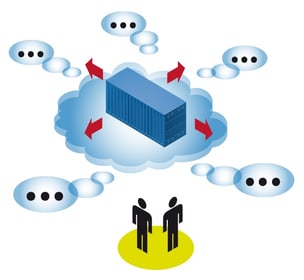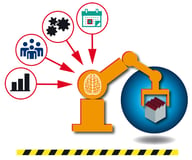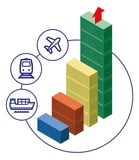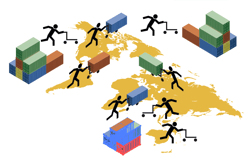Can Transport Logistics Drive Growth?
Nick Ostdick - October 17, 2017

 “If you’re not growing, you’re dying.”
“If you’re not growing, you’re dying.”
While a little hyperbolic, this is an old saying often at the heart of discussion for so many of today’s manufacturing companies when it comes to expansion, increasing their market footprint, and raising their visibility in a very competitive field of play. The expectations and realities for manufacturing companies to create long-term, sustainable growth while at the same time showing signs of robust, short-term success is a delicate balancing act planners and managers are faced with executing at each touch point of the value chain. Because so much of today’s production cycle is connected through the integration and digitization of the supply stream, various process must work in tandem in order to achieve growth opportunities and propel companies into a prosperous future.
However, one aspect of global supply chain management (SCM) often overlooked in this discussion is transport logistics. Or, very simply: the act of successfully moving products from the production floor to the customer’s front door. It sounds quite basic, yet in an era of varied partner networks and variant-rich production programs, it can actually be a significant challenge for manufacturing companies across an array of industries. But for companies that deploy a successful transport logistics strategy, there are a great many benefits to be experienced beyond simply delivering products during pre-defined delivery windows. In fact, transport logistics can actually help companies achieve the growth they seek?
But how? How can a transportation management scheme actually provide manufacturing companies with a path for growth? Let’s examine a handful of ways a transport logistics platform can drive real growth and help companies create business moments in today’s production landscape.
Mitigating operational costs and risks
Transport logistics are not a fixed element of global supply chain management. Because of the variables involved (fuel costs, routing detours or delays, variances in weight, and other aspects), there are inherent risks with moving finished products across a varied partner network with the end result being the customer. Because a transport logistics solution gives planners and managers the power to call and review data related to fuel consumption and prices, reliability of transport routes, full load versus less than full load, and even factors such as weather or route disruption, companies can in real-time make adjustments to transport planning to avoid such complications or disruption. However, this foresight can also provide manufacturing companies the capacity to seize moments when shipments or products can be combined for a final destination, when fluctuations in fuel can be exploited for greater freight volumes, or when new transport routes can be leveraged on a continuing basis to optimize delivery schedules. Each of these aspects can equal growth moments for companies that previously did not exist without a transport logistics solution.
Integrating Industry 4.0 principles
Because Industry 4.0 relies heavily on intelligent solutions communicating data, reporting, and notifications in real-time, Industry 4.0 is perhaps a perfect fit for transport logistics in terms of identifying changing variables in transportation constraints and addressing these variables before they result in breakdowns or bottlenecks. We’ve discussed at length on this blog about the importance of incorporating Industry 4.0 principles into a larger planning and production platform, and transport logistics are no different. While transport logistics is reliant on a large network of partners, stages, or processes, integrating Industry 4.0 into a transport strategy is a seamless way of connecting these disparate points into a cohesive system or architecture whereby all the important players can communicate, collaborate, and respond to transport logistics events with little or no lead time. The value proposition here in terms of growth is manufacturing companies, because of the interconnected nature of operations via Industry 4.0, will have a greater, more in-depth understanding of where their supply streams are the greatest functioning and where functionality is limited.
This allows for corrections, modifications, or adjustments to trouble processes or aspects. Essentially, Industry 4.0 within the realm of transport logistics allows companies to hone in on a negative and transform it into a positive, which can unlock unseen areas for growth.
Adapting to shifting constraints
Let’s take a hypothetical example of a certain production program scheduled to produce a certain amount of units that need to be transported to a certain distribution facility by a certain date. However, unforeseen changes to said production program means a significant reduction in the number of units, which directly impacts transport capacity. Where before a manufacturing company had budgeted enough space to move a certain number of units, this reduction either means a longer lead time to when a full truck/container can be shipped, or an inefficient use of capacity whereby a half or less than half truck or container is utilized. However, a transport logistics strategy and solution gives planners and managers the power to adapt to these operational shifts by identifying the best routes, transport modes, and delivery windows to avoid incurring losses in resources and time in addressing these changing variables.
In addition, a transport logistics solution allows manufacturing companies to engage in simulations and what-if scenarios and to leverage the results and data from these simulations to ID how similar cases might be exploited in the future. If a manufacturing company can essentially predict or hypothesize like-minded occurrences in the short or mid-term future, these instances can be planned for and used as a moment to deploy new transport logistics strategies with an eye toward enhanced operational efficacy.
LATEST POSTS
- Understand Why Production Planning Needs Specialized Solutions
- Understand Circular Economy in The Manufacturing Industry
- How Can Industry 4.0 IT Integration Be Achieved Smoothly?
- The Significance of Order Sequencing in Discrete Manufacturing
- How to improve your Supply Chain Management: The Power of Control Towers



